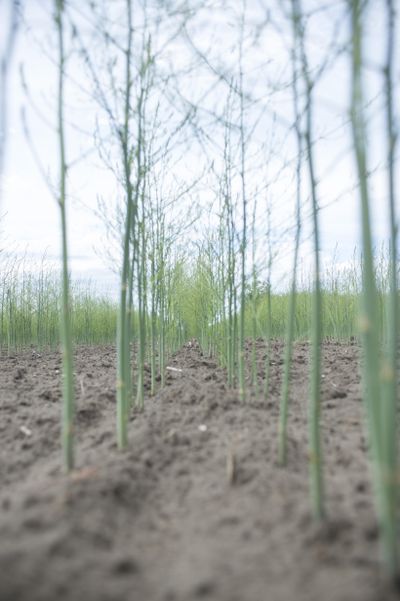Gardening: Asparagus requires space, patience, Pat Munts writes

Spring is asparagus season. The tender green spears appear almost magically from bare ground in many places in the Inland Northwest, and not all of them are in backyard gardens. To those in the know, there are wild patches of asparagus around old farms and homesteads, in empty fields and moist ditches. There is reportedly a patch somewhere on the old Fort Wright grounds where the military cooks grew vegetables for the soldiers in the early 1900s.
Growing asparagus is not difficult, but it takes a lot of garden space, some work to plant it and patience for it to grow to harvest age.
Asparagus grows from a root called a crown. The crown has multiple long fleshy rootlets topped with a growing tip. The crowns are available in the early spring in garden centers and online. It needs full sun and a well-drained sandy loam soil. A planting of asparagus can produce for 15 years or more, so it should be planted at the edge of a garden area or in its own separate bed where it can grow undisturbed.
Select large, plump roots with a good growing tip. Each root will produce about a half a pound of spears when it’s mature, so buy enough roots to satisfy the cravings in your household. Dig a trench 8 to 10 inches deep and fill the bottom with a couple of inches of good-quality compost or manure. Set the crown out 18 inches apart and cover with 2 inches of soil. Wait until the crowns send up a few shoots and then fill in the rest of the trench. Mulch around the new shoots with an inch of shredded pine needles, leaves or bark to keep the weeds at bay. Asparagus foliage is fernlike and can grow to about 3 feet tall.
An asparagus planting takes about four years to fully mature. A 1-year-old planting can be lightly harvested once. In the second year, harvest for about two weeks. In the third year, about three weeks. Starting in the fourth year, a bed can be harvested until the spears start to get smaller. These smaller spears will grow into the year’s fronds and replenish the roots. To harvest asparagus, slip a sharp knife into the soil at the base of a spear and gently cut it off.
Asparagus doesn’t like competing with weeds, so keep your planting well weeded and mulched. Fertilize them in the very early spring with a 10-10-10 fertilizer. Asparagus is moderately drought-tolerant but will benefit from deep soakings during July and August. Remember, its roots are at least 6 inches deep, so the water must go deep. In the fall, the fronds can be cut down or left until spring for winter interest.
There are dozens of varieties available to grow, but some of the best known include Mary Washington, Jersey Giant and Jersey Night. Purple varieties such as Purple Pacific and Purple Passion are also becoming popular. They have smaller yields but larger spears.
Pat Munts has gardened in Spokane Valley for over 35 years. She is co-author of “Northwest Gardener’s Handbook” with Susan Mulvihill. She can be reached at pat@ inlandnwgardening.com.